Woman face of mercyNina Kovaleva*Whatever they say about backwardness of Russia in general, about supposedly traditional absence of civil conscience and, at last, about absence of civil rights with Russian women, - all this allegations cannot stand the test of facts within at least the last century. The history draws quite different picture of social life and quite different portrait of woman in Russian Empire: economically independent, socially active, well educated and well developed spiritual make-up. This was the real image of representatives of the nobility and merchants, officialdom and petty bourgeoisie (since in the present cycle we speak about the propertied classes which can render considerable assistance). In the questions of mercy everybody is equal in ability. Everybody can give up a big part of his property, guided by his principle of reasonable sufficiency. Everybody can give up a part of his property upon good consideration and attaching to this gift serious financial calculations plus personal efforts, as well remarkable ones. And then our memory will remember everybody: Mrs. Zakharyina, who left by will testament all her fortune for construction of the hospital in the village of Kourkino; Mrs. Barishnikova, who founded the refuge for chronic invalids in the village of Nikolo-Pogorelom of Dorogobouzhsky district of Smolensky province; Mrs. Yakovleva (born Sklifasovskaya), who opened a college in the settlement of Golitsinsky Gorodok at her own expense; Mrs. Chetverikova, who endowed 100 thousand rubles for construction of tuberculosis sanatorium; Mrs. Bobrinskaya, who established doss-house for women; Mrs. Kelyina, who gave funds for establishing of a kindergarten; Mrs. Poloudenskaya, who endowed 80 thousand rubles to a hospital; Mrs. Paskhalova, who endowed a considerable sum of money to University clinics; Mrs. Velikolepova for more than half million donations in favor of the city of Moscow for charity…
Though Tatiana Gurieva was not very active she managed to declare about herself loud enough even for owner's society and due to it she was honored with a personal "photo on a separate page" in the historical folio. Intending to realize a good deed -to help incurable patients to live the remaining life without torments - Tatiana Gurieva had to choose a reliable assistant for herself. Her choice fell upon a representative of her own class - Ivan Grigorievich Prostiakov, merchant belonging to the top guild, famous for his activity in charity establishments of Moscow merchants.
The specialized school had a private status for sixteen years. In 1903, according to the will of the donor, the school was transferred to the possession of the city; in addition to it V. Ya. Lepeshkina commissioned executors of her will "together with the specialized school to hand over to the city the capital of 500 thousand rubles, the interest from the latter to be used for the school financing". Thus she granted not only material values to the city, but as well a ready and well functioned training establishment, provided with funds for further operation. The first similar charitable perpetuum mobile was proposed by brothers Solodovnikov, also the merchants. In the Charter of their first almshouse, which was approved by Emperor6 in 1862, they used a very similar scheme: at their own expense and using their own land to erect and equip building of the almshouse, to keep with their own money the wards for four years and then to transfer the almshouse to the possession of the merchants society, providing it with guaranteed financing "for ever" in the form of interest from additional capital. Not a fine gesture but a strict calculation -indication of a civilized charity- was chosen by Varvara Lepeshkina, wife of a businessman and daughter of a businessman. Her gift was appreciated at its true value by the city authority7. "Izvestia Moskovskoy Gorodskoy Dumy (News of Moscow State City Council)" especially stressed that "this school did not cost a petty kopeck (penny) to the city and not only covered all its annual expenses but, on the contrary, gave a certain profit". In the eyes of her contemporaries, who were always thrifty towards community property, the Lepeshkina's donation distinguish itself from the similar establishment for boys, which had been transferred to Moscow by V. A. Morozova. Accepting the gift, costing 150 thousand rubles, from the famous millionaire, at the same time "Duma had to assign for the school running costs 21 thousand rubles annually". August 12, 1911 became a real event for Moscow though the city was always a recognized leader in charity. On that day a solemn opening of a new charitable establishment took place - "Almshouse named after St. and An. Tarasovs for poor old people, both men and women, of Orthodox Christian belief". Anna Pavlovna Tarasova, widow of the former City Council Head, left by will testament more than 900 thousand rubles to the city. Construction of the three-storey building cost 250 thousand rubles, the rest was intended for its running costs. Every ward was due to a small separate room, free access to the library and, should it be necessary, he could visit doctor and pharmacy. All the premises had parquet floors. The building was well technically equipped: central heating with "ventilated air" and electric light. The opening of almshouse named after the Tarasovs8 was attended by N. N. Gouchkov, City Council Head, and members of the City Council.
Lyamin's daughter was not behind her brothers. After his death and in memory of her father V. I. Doubrovina (born Lyamina) transferred to the possession of the city a house in Ordinka Street to be used as a refuge for old women and temporary shelter for homeless children. The wards in question occupied three-storey building: women were on the ground floor and children - on two upper floors. These establishments were headed by the Guardian Council, consisting of five persons, and by the member of the City Council, supervising the charitable activity. The members of the Guardian Council were elected by the Duma. The Guardian Council was responsible for admission of the children-wards, for settling them in future in new permanent places and "for care of their future destiny". In the history of charity there are women actions quite understandable, due to their wish to support the public status of a family. But women soul is very mysterious, moreover since so long a time. Many proving documents are lost, no written evidence is left. Thus it is so difficult to explain what made a widow, who was not backed by incredible fortune or by famous reputation of her husband, be so good to the most unprotected - to old men and children. Name of Gueher is represented in the history of Russian charity by two establishments, paid with donations from Natalia Petrovna Gueher. The first one is the city orphanage. Initially it was intended only for the children, who became orphans because of the catastrophe on Khodinskoe polie during the coronation of Nikolai II, but during the construction it was decide to extend the list of children to be admitted to the orphanage. Natalia Petrovna Gueher transferred to the city ownership of the land lot to a total value of 250 thousand rubles and the city, in its turn, constructed the building. The donation in question was so considerable that the name of the orphanage included wording "on the former land of Gueher". The city fathers realized that "thus this donation partly compensated the expenses of the City Council Land Fund". Permission to name the new establishment after somebody had to be received "at the very top". In April 1895 the "highest approbation" was issued to name the orphanage, established by the City Council, as "orphanage, located on the land, endowed by Mrs. Gueher to Moscow, and named after Iosiph Nikolaevich Gueher, husband of the donor". The orphanage was opened a year later and was patronized by Empress Alexandra Fedorovna. It admitted boys and girls aged from three to eight, whose parents had spent in Moscow more than two years. Eldest children went to the city school, juniors studied three R's and needlework with orphanage teachers. Three years later Natalia Gueher granted to the city an almshouse. Old men and women were admitted there under orders from the City Council. Taking into account specifics of its patients the almshouse included infirmary with medical attendant. New charity abode as well was named after I. N. Gueher. Doing good deeds somebody wanted to dedicate them to the memory of her husband or his wife, of his or her father, but the richest woman in Russia, for example, established in one of the almshouses a bed named after her son Savva Morozov. In every case the will of the donor was followed rigorously - in that way the life continued in direct and figurative sense in the houses, which were so good to people and rather often became adornment of the city. It's a pity that these names disappeared in the epoque of struggle for social justice, since these very names were the symbols of tendencies, developed in the public conscience9. In the period when centuries replace each other the aesthetic postulate that the fortune obliges became absolute truth. The dictionary by Brokhouse and Efron interprets charity as "moral obligation of the wealthy to hasten to the help of the poor". Pleasing to God and gentle charity, with a touch of complex of guilt, on the first hand, and revolutionary impulse or outburst, without any doubts and ready to shake the world, on the other hand, at first sight are quite different things. But they have one and the same goal - to achieve social justice and mechanism for its achievement is as well the same - redistribution of capital (no alternative was found yet). Nevertheless, to drive these two phenomena to opposite poles one difference, though of fundamental nature, was quite enough; this difference is a principle of one's own free will in charity. *Continuation of series of publications - ## 1,2,3/2001, # 1/2002 1At present, it is stomatological polyclinic # 6 2Moscow Center for International and Comparative Education 3Administration block of the Institute of Surgery named after Vishnevsky, Russian Academy of Medical Science (RAMN) 4Department of wounds and wound infections of the Institute of Surgery named after Vishnevsky, RAMN 5Burn Center of RAMN 6Legislation stipulated that the Charter of any charitable establishment should be approved by Emperor personally 7Since not every donation, burdened with terms, could be accepted 8Building of the Pension Fund 9Information on continuity of forms and partly of principles of social aid in the period after 1917 - see "Nezavisimaya Gazeta" of 21/08/1996. |
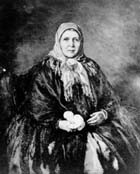 A lot of glorious women names and a lot of glorious deeds and as a response - honor and respect from the contemporaries. Sometimes the esteem and honor were so great that nowadays they can bewilder us. Really, today it is a bewilderment that the portrait of a completely unknown Mrs. Gurieva from the merchants was printed on the first pages of the jubilee edition of the History of the Moscow merchants society, immediately after official photos of the Emperor's Family. This kind of unexpected turn of events today is considered as a direct challenge to patriarchal moral principles of the merchants. But in this case our reaction is caused by the still existing myth of the "kingdom of darkness", invented by Dobrolyubov. And it is very difficult to oppose a talented and politically composed pamphlet. In XIX century critic Apollo Grigoryev, writer-publicist Nikolay Pogodin, the merchant sister Tatiana Gurievna Gurieva - all of them did their best to fight with this myth.
A lot of glorious women names and a lot of glorious deeds and as a response - honor and respect from the contemporaries. Sometimes the esteem and honor were so great that nowadays they can bewilder us. Really, today it is a bewilderment that the portrait of a completely unknown Mrs. Gurieva from the merchants was printed on the first pages of the jubilee edition of the History of the Moscow merchants society, immediately after official photos of the Emperor's Family. This kind of unexpected turn of events today is considered as a direct challenge to patriarchal moral principles of the merchants. But in this case our reaction is caused by the still existing myth of the "kingdom of darkness", invented by Dobrolyubov. And it is very difficult to oppose a talented and politically composed pamphlet. In XIX century critic Apollo Grigoryev, writer-publicist Nikolay Pogodin, the merchant sister Tatiana Gurievna Gurieva - all of them did their best to fight with this myth.
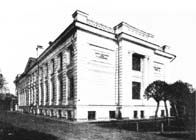 About intention of Tatiana Gurieva to endow 300 thousand rubles for almshouse, he declared in written application put forward to the Merchants Board on July 16,1893. In addition to it hereditary honorable citizen Ivan Prostiakov committed himself to "construction and furnishing of the house in question". A week later Tatiana Gurieva specified: "the building should be erected on the land lot of Moscow Merchants Society, which earlier belonged to A. G. Solodovnikov, and is located in Schipok street". It was not an occasional decision, but a result of zealous and economical approach. Schipok street at that time accommodated a whole complex of Solodovnikov almshouse
About intention of Tatiana Gurieva to endow 300 thousand rubles for almshouse, he declared in written application put forward to the Merchants Board on July 16,1893. In addition to it hereditary honorable citizen Ivan Prostiakov committed himself to "construction and furnishing of the house in question". A week later Tatiana Gurieva specified: "the building should be erected on the land lot of Moscow Merchants Society, which earlier belonged to A. G. Solodovnikov, and is located in Schipok street". It was not an occasional decision, but a result of zealous and economical approach. Schipok street at that time accommodated a whole complex of Solodovnikov almshouse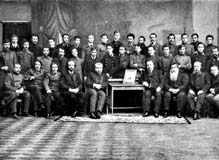 Varvara Yakovlevna Lepeshkina (born Prokhorova) came down from the same merchants' milieu. The Lepeshkins were famous in Moscow. The University first hostel (campus) was called by students "Lepeshkin's hostel" after the name of its founder; in Ekaterininsky and Demidovsky almshouses there were more than twenty beds, kept at the expense of the Lepeshkins.
Varvara Yakovlevna Lepeshkina (born Prokhorova) came down from the same merchants' milieu. The Lepeshkins were famous in Moscow. The University first hostel (campus) was called by students "Lepeshkin's hostel" after the name of its founder; in Ekaterininsky and Demidovsky almshouses there were more than twenty beds, kept at the expense of the Lepeshkins.
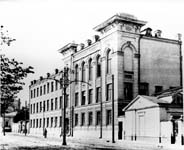 Establishment of a specialized school for the girls met close attention of Varvara Lepeshkina. The new building was erected on the allotted land, the training premises and workshop for machine-knitting were well equipped. The task was a large-scale one - to support spreading of the professional and general secondary education. Girl-students could choose one out of two main alternatives. The period of training at the general education department was six years and the graduates were prepared for teaching of three R's and needlework at primary schools. At the professional department the girls studied household, tailor and seamstress handicraft; all courses included the so called fine needlework.
Establishment of a specialized school for the girls met close attention of Varvara Lepeshkina. The new building was erected on the allotted land, the training premises and workshop for machine-knitting were well equipped. The task was a large-scale one - to support spreading of the professional and general secondary education. Girl-students could choose one out of two main alternatives. The period of training at the general education department was six years and the graduates were prepared for teaching of three R's and needlework at primary schools. At the professional department the girls studied household, tailor and seamstress handicraft; all courses included the so called fine needlework.
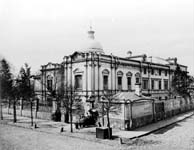 Post of Moscow Mayor at that time was very closely linked with charity. The public opinion was formed in such a way that the Mayor according to his position had to be merciful and compassionate. From that point of view the contemporaries regarded famous Tretiakov, Alexeev, Roukavishnikov (our cycle envisages a story about the latter one). Ivan Artemievich Lyamin as well occupied the high position of the mayor; not once his sons Semen and Serguei were elected to the Duma. Their service list comprised honorable membership and high posts in many charitable establishments, among them the Ladies committee of Red Cross, Iverskaya community, Charity Society of the blind men, Moscow Council of orphanage.
Post of Moscow Mayor at that time was very closely linked with charity. The public opinion was formed in such a way that the Mayor according to his position had to be merciful and compassionate. From that point of view the contemporaries regarded famous Tretiakov, Alexeev, Roukavishnikov (our cycle envisages a story about the latter one). Ivan Artemievich Lyamin as well occupied the high position of the mayor; not once his sons Semen and Serguei were elected to the Duma. Their service list comprised honorable membership and high posts in many charitable establishments, among them the Ladies committee of Red Cross, Iverskaya community, Charity Society of the blind men, Moscow Council of orphanage.